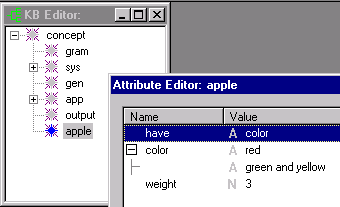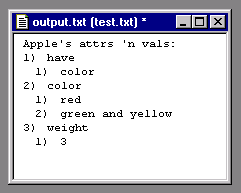
Fetch value as a string from a numeric or string-valued KB value object.
returnedString = getsval(aValue);
returnedString - type: str
aValue - type: val
A string, returnedString, representing the name of the input value, aValue.
Concepts can have zero or more attributes. Each attribute can have zero or more values. This function takes a value as argument and returns the string name associated with the input argument value. Differs from getstrval, in that getsval can handle either numerical or string values in aValue, while getstrval expects a string. Differs from getnumval in that getnumval expects a number in aValue. If passed a bad argument value, the function writes an error message to the output log.
To demonstrate getsval, we first need to build a KB:
# if you find apples in the concept hierarchy
if (findconcept(findroot(),"apple"))
# kill them (to start fresh)
rmconcept(findconcept(findroot(),"apple"));
# Create the apple concept
G("apple") = makeconcept(findroot(),"apple");
# Apples have color
addstrval(G("apple"),"have","color");
# Apple's color is red
addstrval(G("apple"),"color","red");
# Apple's weigh 3 something or others
addnumval(G("apple"),"weight",3);
# Apple's color is also green and yellow
addstrval(G("apple"),"color","green and yellow");
The code creates a KB like this:

(To launch Attribute Editor, select the concept in the KB Editor, right mouse click and select Attributes from the popup menu).
The following code accesses the KB's attributes and values:
"output.txt" << "Apple's attrs 'n vals:\n";
# Find apple's attribute's
G("attrList") = findattrs(G("apple"));
# cycle through all of apple's attributes
G("attr counter") = 1;
while(G("attrList")){
"output.txt" << G("attr counter") << ")\t" <<
attrname(G("attrList")) << "\n";
# get the attribute's list of values
G("valList") = attrvals(G("attrList"));
# cycle through all the values
G("val counter") = 1;
while(G("valList")) {
"output.txt" << "\t" << G("val counter") << ")\t" <<
getsval(G("valList")) << "\n";
G("valList") = nextval(G("valList"));
G("val counter")++;
}
# get the next attribute
G("attrList") = nextattr(G("attrList"));
G("attr counter")++;
}
The output looks like this:
